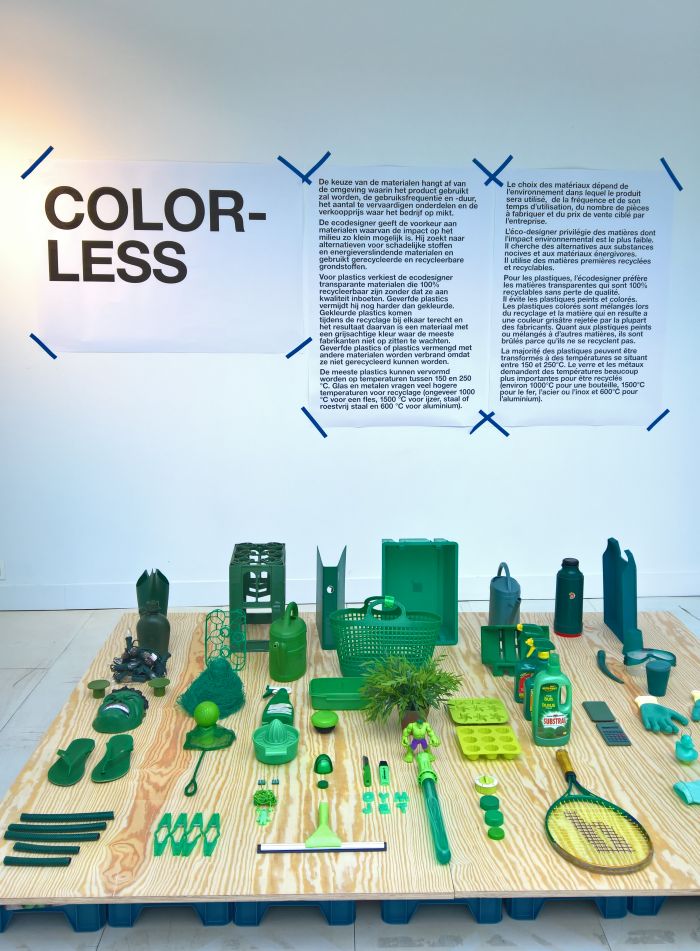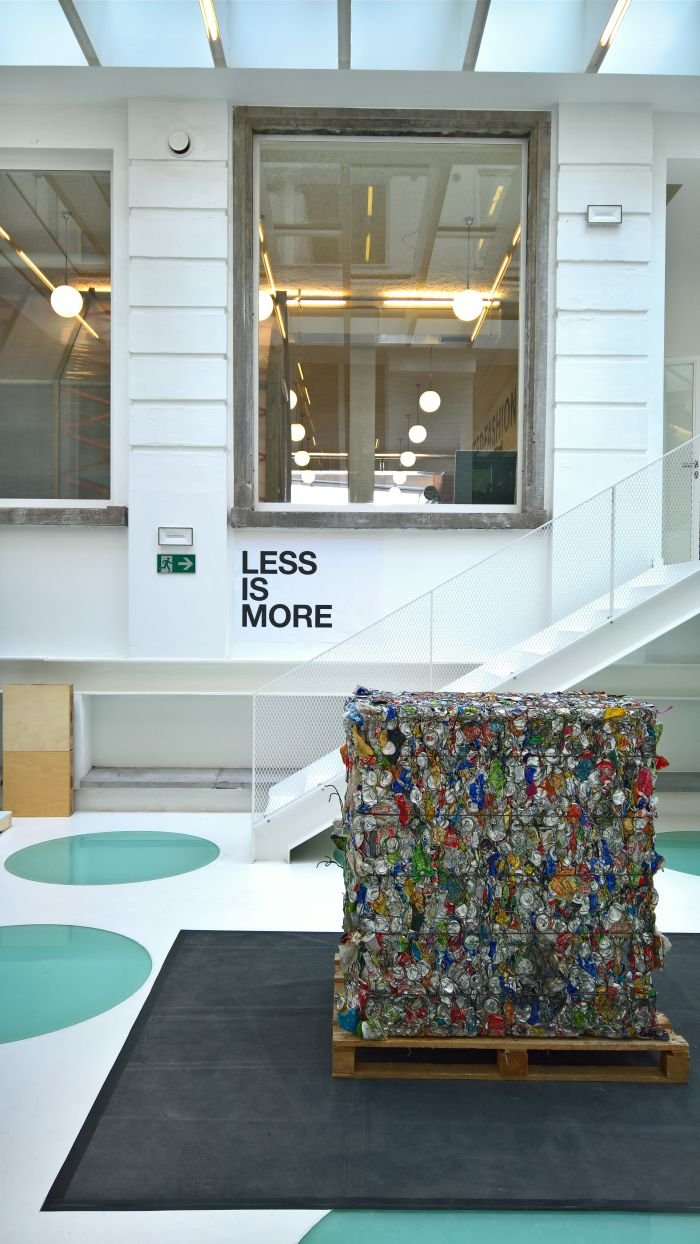Everything should be Ecodesign, opines the tag line to MAD Brussels' exhibition Buy Now, Pay Later.
And while we are, arguably, (at least a little) further advanced in terms of ecological, sustainable, design thinking than we were a generation ago, we still have a long way to go.
Buy Now, Pay Later highlights some of the areas where we could do better.......
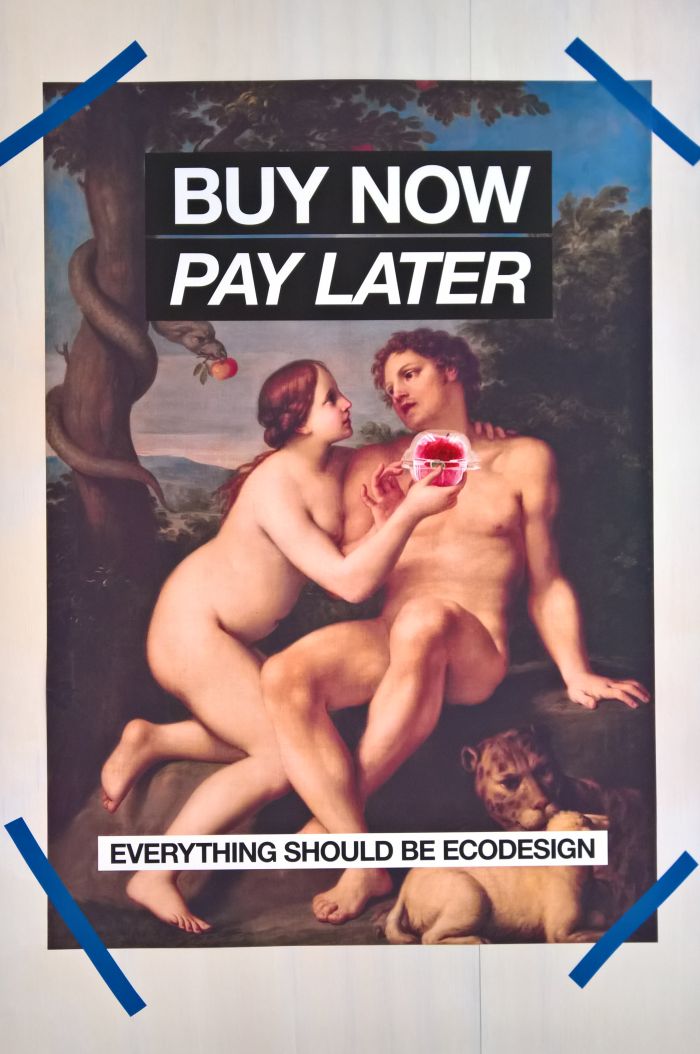
In 1972 the Club or Rome report "Limits of Growth", warned that if we didn't change our ways, life on earth was doomed. In 2018 everyone is awfully concerned that the oceans are full of plastic. In 1972 the Club or Rome report "Limits of Growth", warned that if we didn't change our ways, life on earth was doomed.
As we've noted before, and fear we will have to note again, as a species we really aren't as clever as we like to think we are. We really, really aren't. If we were we'd understand that our actions have both short-term and long-term consequences, that what currently appears innocuous could become a future problem, and react accordingly to minimise/negate the risk. Prevention always being better than cure.
Buy Now, Pay Later is in many regards a call for more prevention. And while we have a few problems with the term "Ecodesign", implying as it does a genre of design distinct from product, textile, industrial etc, much preferring a term such as ecological thinking in design, ecological responsibility in design, ecological necessity in design, we do appreciate that such alternatives are a little ungainly in context of an exhibition title, and so we will run with Ecodesign.
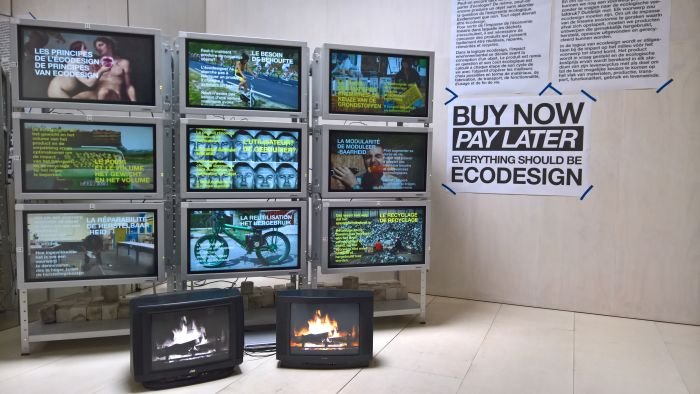
Buy Now, Pay Later opens with an explanation of what curators Laurence Soetens & Thomas Vancraeynest understand by Ecodesign, if you will, the, for them, key components, including in addition to the three R's Repairability, Reusability, Recyclability, more fundamental considerations such as need, weight:volume ratio, modularity, and, and arguably as most fundamental of all: l'utilisateur, de gebruiker, the user. You.
You, we, us all have the power to force change, to force industries, governments, our friends and families, ourselves primarily, to produce, distribute, consume more ecologically, and socially, responsibly. But before we can we need to understand the contemporary issues, if you will, to understand the oceans of plastic that we will be surprised and distressed to find in 50 years.
And as Buy Now, Pay Later nicely highlights, that isn't necessarily easy, not least because of the challenges associated with evolving and advancing technology, evolutions and advancements which may offer an improvement on previous realities but aren't without their own long-term risks: electric cars, for example, may be an improvement on the internal combustion engine, but (a) need electricity and (b) how do we dispose of the batteries when they are no longer functional?; and while the paperless office, and paperless communication, billing, administration means less reliance on paper, ink, transport etc, the internet and digital communication bring their own problems. Problems absolutely deliciously represented in Buy Now, Pay Later by monitor screen, after monitor screen, after monitor screen, with pictures of cats, and thereby that meme that perhaps most perfectly illustrates how society has completely failed to grasp either the power of the internet or the potential long-term impact of digital technology.
The internet needs electricity, not just for running your actual device but also all the hardware required to both facilitate the necessary transfers of information and also the storage of information. And 67 billion utterly pointless pictures of cats. The Cloud may sound like a ephemeral thing, may even sound harmless and eco-friendly, is, logically, a very real physical thing that requires electricity. And requires ever more the more information it needs to store. Every cat picture, every Instagram post, every WhatsApp emoji raising the electricity demand.
Which is one of those things that annoys us when we see designers develop apps that, for example, tell you when food in your fridge is about to go off. Look in your fridge. Don't use electricity to get a computer to tell you what is happening in your fridge. Or video doorbells!!! If you're not in your not in. If you are you are. It's not difficult.
Or put another way, wonderful and liberating as the internet and digital technology are, they aren't pollution free. You just can't see it. If you could, if you knew the impact of your online behaviour, you might change your behaviour: in her graduation project Cutting Carbon at the Willem de Kooning Academy Rotterdam, Iris van Oord proposed rucksacks symbolising a percentage of your daily carbon footprint. In Buy Now, Pay Later the cats look a lot less cute when you understand their long-term consequences.
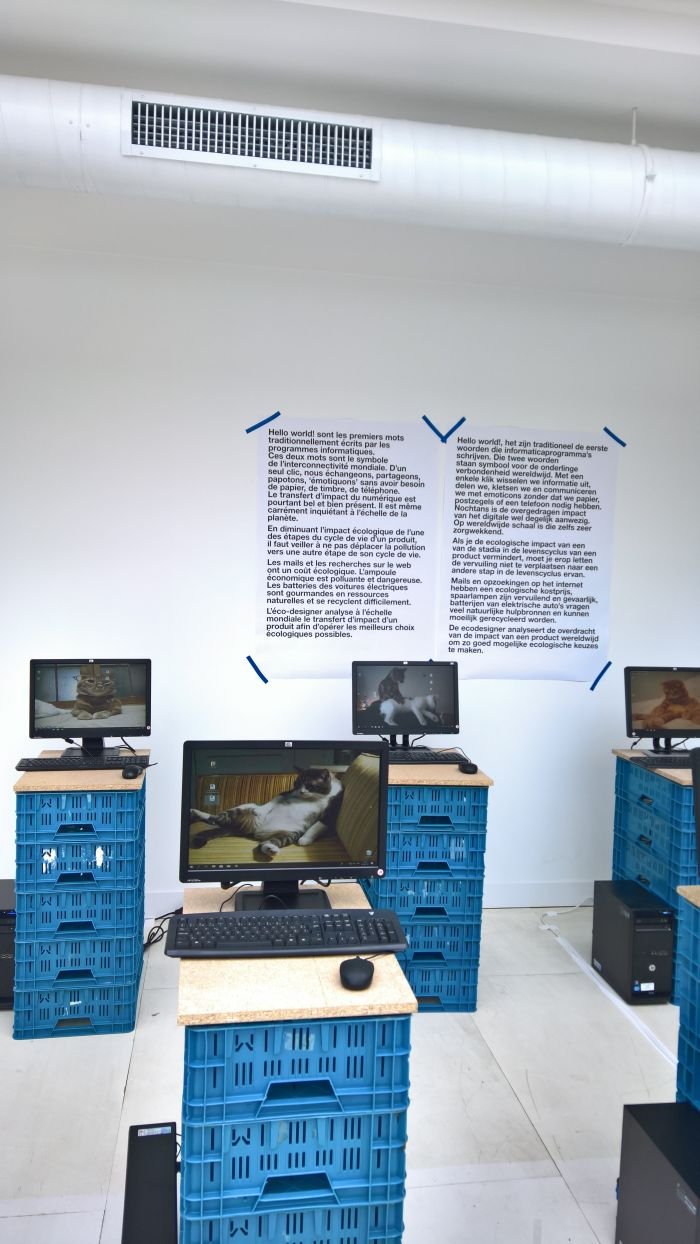
One of the more complex issues in terms of environmental sustainability in design is plastics. While there are unquestionably arguments that we would be in a much better position if plastics had never been developed; plastics have also unquestionably contributed greatly to the development of society, and can continue to do so, it is a question of our relationship to plastics. Of understanding the nature of plastics and making properly informed decisions.
Something previous generations were notoriously awful at. While all can quote that a butterfly flapping its wings in Argentina can cause a storm in China, no-one seems to have realised that packaging everything in plastic and then throwing it away might cause problems down the line.
Which, and in (partial) defence of previous generations, is also related to the problems of identifying future risks in new technology, in the 1950s and 60s plastics were the answer to all society's ills, or as we noted in our design calendar post on the 1971 exhibition Italy: The New Domestic Landscape at the Museum of Modern Art, New York, "with the benefit of neigh on five decades hindsight one is struck on the one hand by how dilettantish, naive, many of the participants were in their reliance on plastics..... And on the other, how little we have progressed"
Buy Now, Pay Later provides for a very nice, undogmatic, almost detached discussion on several considerations on the use of plastics in context of their recycling, and therefore enabling better informed decisions on our relationship to plastics, noting, for example, that clear plastic is more readily recyclable than coloured, or that plastics are recyclable at lower temperatures than glass or metal......Temperatures burn resources. Our resources are finite, ergo......
Recycling isn't however just a question of us making our waste available for recycling, products need to be recyclable, need to be so constructed that they can be separated into their component parts, and that those component parts are recyclable, and that is the job of the designer, to ensure that they consider the future life of the object when making decisions on subjects such as materials, production processes, connections, etc, etc, etc.
And a discussion staged in Buy Now, Pay Later in an installation of packaging that takes the most awful liberties with Ateliers J&J furniture. It really is most distressing. But also allows for considerations of Ecodesign in terms of furniture, Ateliers J&J furniture, for example, is handmade in Brussels, from a very limited number of materials, materials which are not only replaceable should that be necessary, but recyclable should you, for whatever reason, have to. And your furniture?
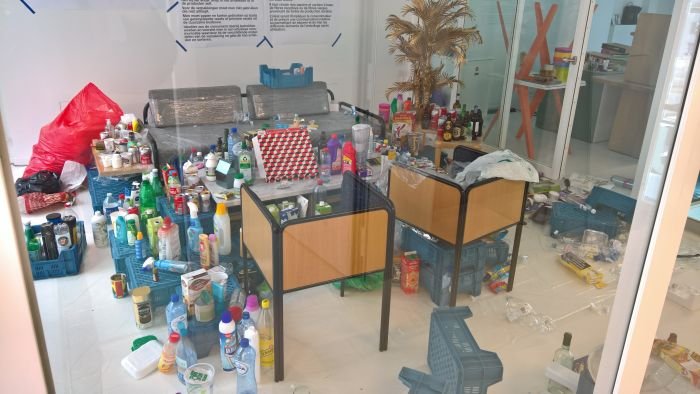
Better than recycling is a long product life cycle, durability and/or reuseabililty, factors which also imply both repairability and that the object is accessible and can be understood by the user.
"Spare parts must be provided. Before buying a product, it is important to inquire about the availability of these parts." advise the curators in one of the exhibition texts.
Which seems an almost quaint, olde worlde opinion, but does have a contemporary relevance, underscoring as it does the problems associated with ecological responsibility as technology advances, and for all with planned obsolescence.
Back in the day repairing your own car was commonplace, parts were readily available and the average engine simple enough to understand so that most people could repair most problems themselves. These days if something goes wrong it's invariably deep in an impenetrable electrical system. And while incandescent lightbulbs weren't/aren't efficient, they could be effortlessly replaced, an inbuilt LED, generally, can't. It may illuminate for 20 years, but when it stops..........?
Despite the contemporary impression, planned obsolescence isn't new, isn't a new ruse by capitalism, one of the earliest examples of planned obsolescence being King Camp Gillette's safety razor with a disposable blade from 1904, itself an example of evolving technology creating a solution which although offering many benefits brought its own problems, and a project inspired by William Painter, inventor of the crown cap, and the man who gave Gillette the memorable advice that if he wanted to get rich he should, “invent something people use and throw away”.
Whereby one must differentiate between that which is thrown away then recycled/reconfigured/reused, and that which is just thrown away. One must differentiate between linear and circular systems. Betwen reasonable obsolescence and wasteful.
Which brings us back to l'utilisateur, de gebruiker, the user. You
You, we, us all have to accept responsibility, social and ecological responsibilty, for that which we consume, not just responsibility for the consequences of its production and distribution but also responsibility for its disposal and future use.
Buy Now, Pay Later looks you in the eye and implies you could do better. Which you know.
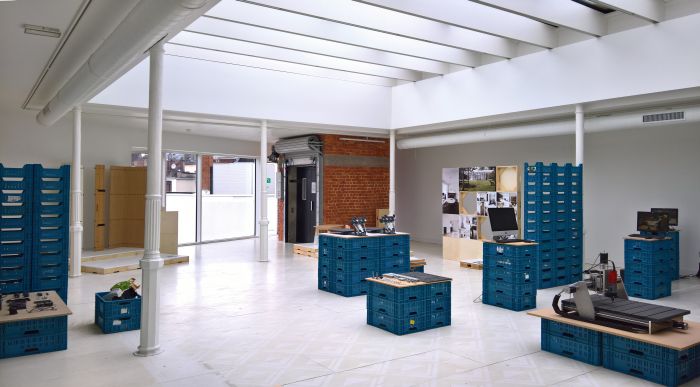
When we visited Buy Now, Pay Later the exhibition wasn't fully assembled, the majority of it was there, and certainly the main tenets and positions were clear. We may however have missed one or the other exhibit/example. Apologies, but time constraints left us no option.
And we may also have missed a re-thinking in terms of the signage. For although the exhibition title and all the subject headings are (were) exclusively in English, the exhibition texts are (were) only in French and Dutch. We say "only," they are the official languages of Brussels and so the signs need not be in any other language; however, for an exhibition hoping to attract an international audience English would have appeared logical. Especially given that it is effectively the third official language of Brussels. We like to think the lack of English is a bit of guerilla, subversive, Brexit resistance on MAD's part: come April 2019 there will be no EU member state whose official delegation language is English*, therefore no reason to speak English in Brussels, so why not return to French as the international language of trade and diplomacy? Worked fine before. And would take Donald Trump out of all loops.
However from what we have seen, as an exhibition Buy Now, Pay Later not only provides for a very clearly defined and readily accessible introduction to some of the contemporary themes in terms of ecological thinking in design, including subjects such as open source, sharing or alternative materials, but does so in a manner that challenges both consumers to question the decisions they make on a daily basis, and also designers to question the decisions they make when realising a project. Whereby we'd advise all designers to always most seriously consider the question if a product is needed, most of that which is designed isn't.
Similarly the most sustainable form of consumption is less consumption and therefore less production, less distribution, less waste; less consumption also implies better consumption, making better informed and more considered decisions about what, why, where, and indeed if, you consume. Buy Now, Pay Later is a good place to start learning to think differently.
And to stop looking at pictures of cats!
Buy Now, Pay Later runs at MAD, Place du Nouveau Marché aux grains 10, 1000 Brussels until Sunday October 7th
* We know that Ireland and Malta both have English as a second official language, Irish Gaelic and Maltese are however their respective primary languages.
Entrance is free and full details, including information on opening times, can be found at https://mad.brussels/
